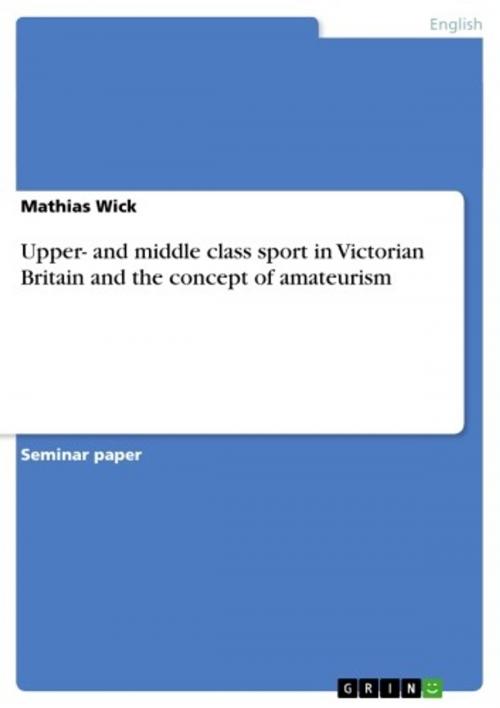Upper- and middle class sport in Victorian Britain and the concept of amateurism
Nonfiction, Reference & Language, Study Aids, ESL, Foreign Languages| Author: | Mathias Wick | ISBN: | 9783638006392 |
| Publisher: | GRIN Verlag | Publication: | February 18, 2008 |
| Imprint: | GRIN Verlag | Language: | English |
| Author: | Mathias Wick |
| ISBN: | 9783638006392 |
| Publisher: | GRIN Verlag |
| Publication: | February 18, 2008 |
| Imprint: | GRIN Verlag |
| Language: | English |
Seminar paper from the year 2007 in the subject English Language and Literature Studies - Culture and Applied Geography, grade: 1,3, University of Potsdam (Institut für Anglistik / Amerikanistik), course: Sport in the Making of Britain, 9 entries in the bibliography, language: English, abstract: The significance of sport as a means to explain dynamic processes in society has increasingly been acknowledged by scholars in the last quarter of the twentieth century. Vice versa it would be difficult, if not impossible, to understand the development of sport if contemplating it isolated and not on the broader background of society in general. This text concentrates rather on sport as a product of other areas such as the working world or politics, but also attempts to outline its initiating role for some changes in British culture. The time to be examined will be the Victorian era, which lasted from 1837 until 1901 and in which Britain underwent remarkable processes of modernization in all areas. It was also the period when sport became subject to remarkable transformations, largely acquiring the features of its modern twentieth century appearance. However, the attempt to describe contexts as multi- facetted as possible will make it necessary to also take a look into the time after and especially before those sixty-four Victorian years. Accordingly, the first chapter deals with sport in Early Modern Britain, emphasising especially the eighteenth century. It is concerned to present an overview, from which more or less universal features of the sports exercised in that time can be derived and which in the later course of the text shall be contrasted with the characteristics of Victorian sport. Those characteristics and its origins will be worked out in the second chapter, when sport is predominantly described as a product of technological modernization and shifting social attitudes. Here also the role of the rising middle classes as the new 'Trägerschicht' (Eisenberg, 1999, p. 47) of sport will receive attention. The third chapter more technically deals with the most common and most popular sports exercised in Victorian Britain, whereat a distinction between upper- and middle class disciplines will be employed in order to present a more differentiated picture. The fourth and last chapter finally recapitulates the way of the middle classes, who managed to become the dominating influence in sport, while contrasting them to the higher and lower orders. With regard to the lower, focus lies on the amateur rule, which emerged in all sports, and which in Guttman's (1979) words 'war eine Waffe in der Auseinandersetzung zwischen sozialen Schichten' (p. 40).
Seminar paper from the year 2007 in the subject English Language and Literature Studies - Culture and Applied Geography, grade: 1,3, University of Potsdam (Institut für Anglistik / Amerikanistik), course: Sport in the Making of Britain, 9 entries in the bibliography, language: English, abstract: The significance of sport as a means to explain dynamic processes in society has increasingly been acknowledged by scholars in the last quarter of the twentieth century. Vice versa it would be difficult, if not impossible, to understand the development of sport if contemplating it isolated and not on the broader background of society in general. This text concentrates rather on sport as a product of other areas such as the working world or politics, but also attempts to outline its initiating role for some changes in British culture. The time to be examined will be the Victorian era, which lasted from 1837 until 1901 and in which Britain underwent remarkable processes of modernization in all areas. It was also the period when sport became subject to remarkable transformations, largely acquiring the features of its modern twentieth century appearance. However, the attempt to describe contexts as multi- facetted as possible will make it necessary to also take a look into the time after and especially before those sixty-four Victorian years. Accordingly, the first chapter deals with sport in Early Modern Britain, emphasising especially the eighteenth century. It is concerned to present an overview, from which more or less universal features of the sports exercised in that time can be derived and which in the later course of the text shall be contrasted with the characteristics of Victorian sport. Those characteristics and its origins will be worked out in the second chapter, when sport is predominantly described as a product of technological modernization and shifting social attitudes. Here also the role of the rising middle classes as the new 'Trägerschicht' (Eisenberg, 1999, p. 47) of sport will receive attention. The third chapter more technically deals with the most common and most popular sports exercised in Victorian Britain, whereat a distinction between upper- and middle class disciplines will be employed in order to present a more differentiated picture. The fourth and last chapter finally recapitulates the way of the middle classes, who managed to become the dominating influence in sport, while contrasting them to the higher and lower orders. With regard to the lower, focus lies on the amateur rule, which emerged in all sports, and which in Guttman's (1979) words 'war eine Waffe in der Auseinandersetzung zwischen sozialen Schichten' (p. 40).















